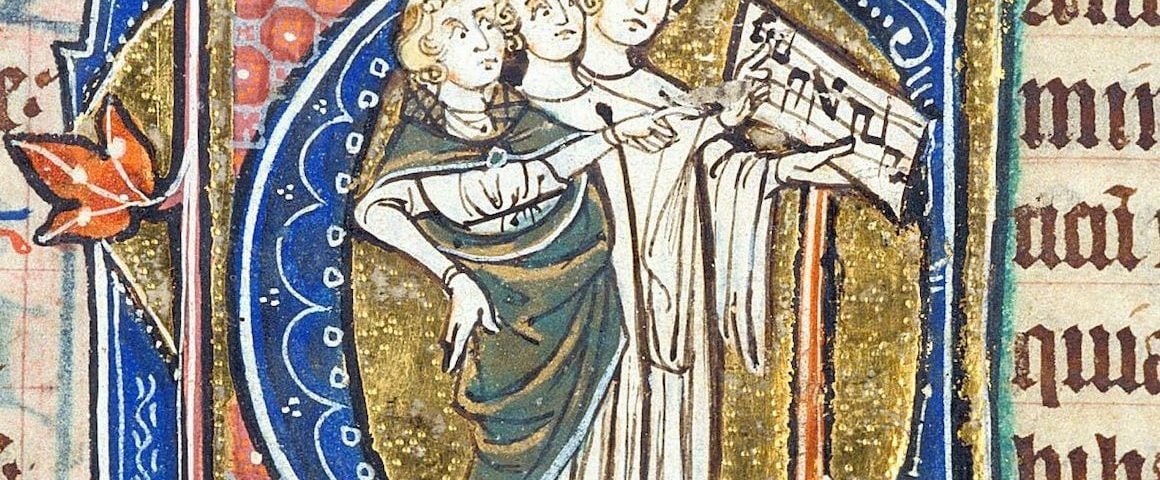William Law once remarked, “For singing is as much the proper use of a Psalm as devout supplication is the proper use of a form of prayer. And a psalm only read is very much like a prayer that is only looked over.”
Anyone who has had the privilege of worshiping in a community that chants the psalms knows exactly what Law is speaking of. However, much of the Anglican choral tradition is built on the idea that the worshipers listen to the choir singing, rather than taking the song on their own lips.
Those who might have the desire to sing, very rarely have access to the means to learn how to do so, teachers and practicing communities being as rare as they are these days.
And then, if you CAN find a teacher, the traditionally Anglican ways of singing the psalms have a long and steep learning curve. Anglican Chant only really “sings” when all four voices are present, which requires a choir. And Plainsong (Gregorian psalm chant), assuming the (usually) square-notes and odd diacritics can be rightly interpreted, has struggles all it’s own. And then, the music needs to not only be learned, but just about mastered in order for the musical aspect to recede from the fore-ground of one’s attention, and the content of the words of the psalm to be the primary focus. In my experience, this takes about four years of daily practice. It’s worth working at, for sure, but few clergy and fewer laymen have the time, ability, or resources to do so.
What can be done?
Some abandon hope of enjoying the chanting tradition, and resort to metrical-psalm hymnody, but this is somewhat less Anglican, and means missing out on the catechetical restraint and simplicity of the chant tradition.
I would like to offer a musical idea.
It is rooted in three sources:
1) I heard once that the uniquely English monastic Gilbert of Sempringham (d. 1189) had his monks chant in monotone, so as to steer clear of the choral decadence that had infected the well-to-do monasteries.
2) Anglican Chant has well established the notion of going off the reciting note only on the ultimate stressed syllable.
3) When one examines Merbeckes’ 1550 pointing of the Book of Common Prayer, it is very interesting to see just how much chant he puts on a single reciting note, with a deviation only at the very end of the line (often, a leap of several notes).
In considering these sources, I experimented for several months on ways of simplifying chant, with the hope of creating a way of singing that could:
- Be used with just an ordinary, un-pointed Psalter, as it sits in the Book of Common Prayer
- Would be able to be learned almost instantly, so as to be accessible to the newcomer
- Would preserve the core musical ideas of the plainsong tradition, namely: The rhythm of speech, and a standard reciting note.
I believe I may have developed something that has potential to make the plainsong tradition do-able for the average Anglican in the 21st century. I call it “Simplified Plainsong”.
It is very simple, and that is the point. Here’s how it works:
The Psalm is chanted on a steady reciting note: Whatever sits comfortably in the throat, and can be sung softly. The last stressed syllable goes off the reciting note. At the end of the first half-verse (before the asterisk), go up one step. At the end of the second half-verse, go down one step. It’s that easy.
Here is a (lo-fi) recording of the psalms as we sung them at morning prayer this morning (sung from the BCP 2019).
Experience has shown that people with zero experience chanting can handle this quite readily, and can jump in on a first try. I have also been able to teach it to kids as young as 7.
While it is certainly not as beautiful as traditional plainsong or Anglican Chant, it does allow the worshiper to engage much more readily with the content of the psalm, and not be distracted about what music to sing. The firm austerity of the near-monotone nature of it, creates a reflective atmosphere in which to really sink into the psalm, and it adds great joy to the Daily Office.
Moreover, it imparts two foundational building blocks to those who would like to go on to attempt plainsong: The ability to chant at the rhythm of speech, and the ability to recognize the last stressed syllable, both of which make the acquisition of the more elaborate plainsong endings easier to figure out.
Give it a try at your next Office, and see if you think it might be a useful tool. My hope and prayer is that — in my parish at least — it will allow us to hang on to the last thread of the Gregorian tradition, before it leaves the room entirely.







'Simplified Plainsong: An Unwritten Musical Resource for Anglicans in the 21st Century?' have 5 comments
September 7, 2019 @ 11:48 am Matthew Brench
This is essentially a step “below” Simplified Anglican Chant! I made a similarly low-quality video earlier this year introducing it: https://saint-aelfric-customary.org/2019/07/19/singing-simplified-anglican-chant/
I’m glad to see more young clerics thinking about this and making chant accessible again.
September 13, 2019 @ 3:31 pm Ben Jefferies
Yes — the difference though that, unlike Simplified Anglican Chant, this proposal for Simplified plainsong keeps the same reciting note throughout. May a hundred usable chant traditions bloom!
September 8, 2019 @ 6:59 pm Micah W.
I think you are going a minor third down (i.e. not technically a step) at the end of the second line! Of course, it works well that way.
Your description reminded me somewhat of the (lesser-used) collect tone, which can be found in the Hymnal 1982 accompaniment edition. Adapting that tone for psalmody: in the first line, it goes a step up on the penultimate accent, and back down on the ultimate stressed syllable. Then on the second line, it would go down a step (as in a major second in music-speak) on the penultimate accent, and again back up.
September 13, 2019 @ 3:33 pm Ben Jefferies
Good to know! Thanks!
September 9, 2019 @ 2:39 am John Fisher
Thanks for this! The simplified Gregorian methods (e.g. St. Dunstan and Nashotah House psalters) don’t seem like they should be much harder than this but…they are.
Another effort you might or mightn’t be aware of is David Madeira’s “Twelve-Point Psalter,” an effort to create something easy to sing but better-sounding than Simplified Anglican chant: https://www.davidmadeira.com/12-point-psalter, https://www.youtube.com/watch?v=h3fahKdjpNQ